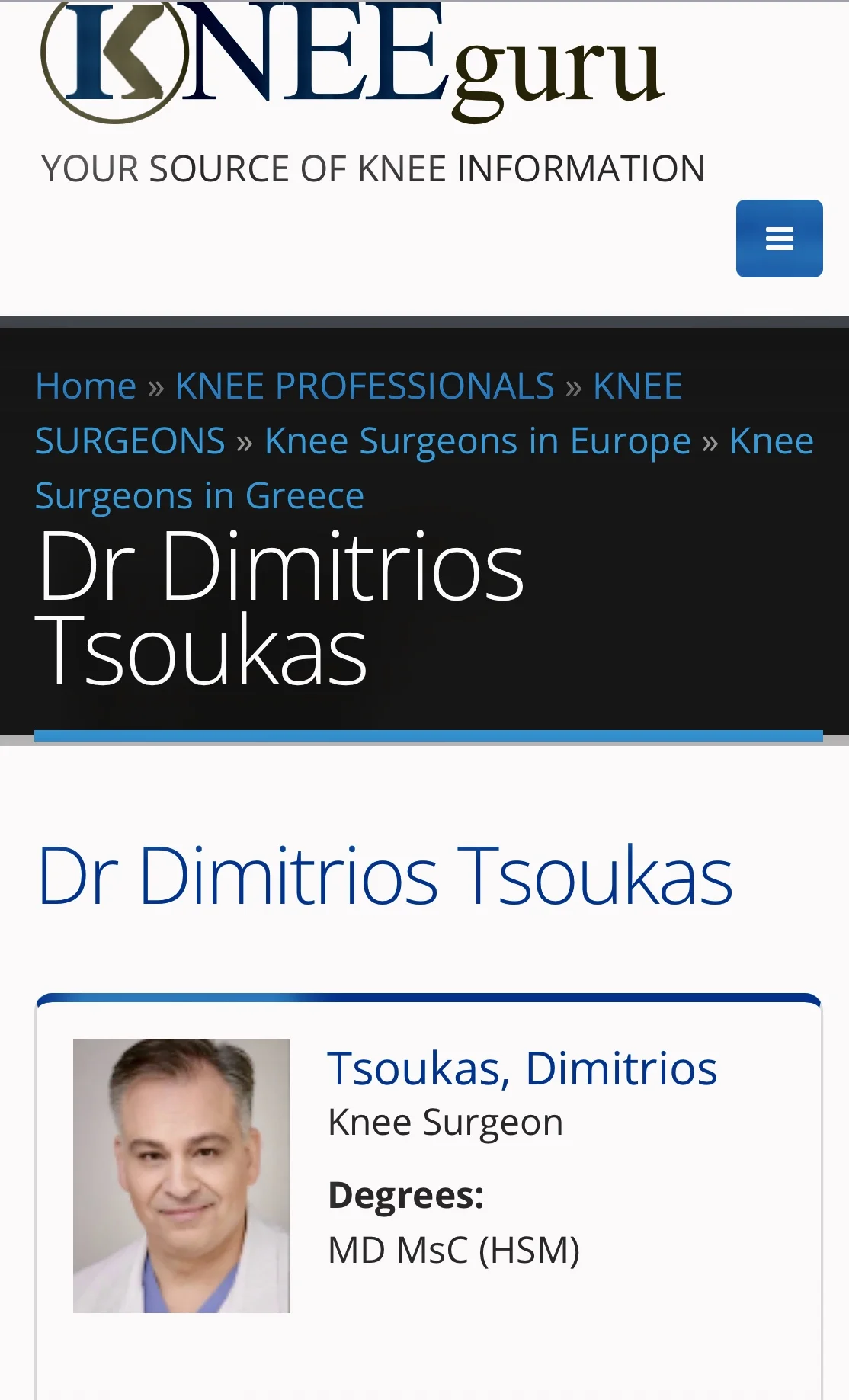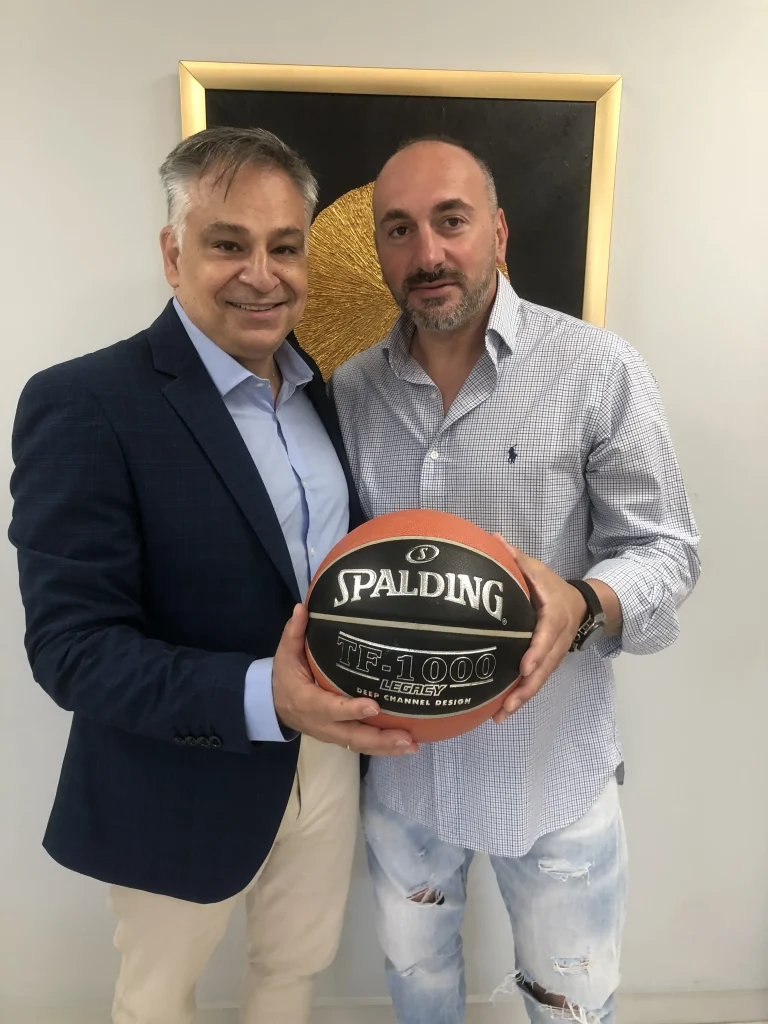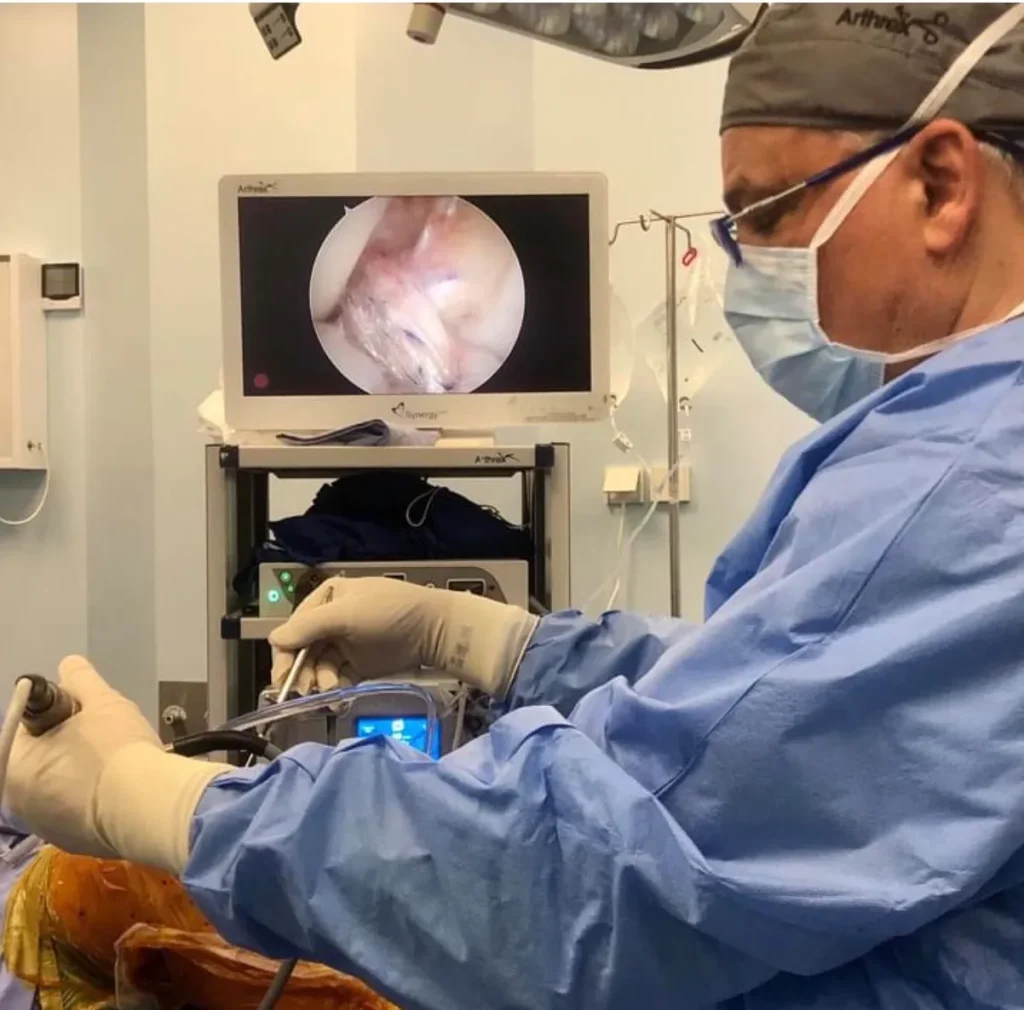25 ans d'expérience dans le genou
Le Dr Tsoukas possède plus de 25 ans d'expérience en chirurgie du genou et arthroscopique. Il est l'un des gourous du genou dans le monde

Rupture du ligament croisé antérieur (LCA). Révision de la liste de contrôle d'accès
Le Dr Tsoukas a réalisé sa première reconstruction de rupture du ligament croisé antérieur en novembre 1999 ! Le patient (AD) était un basketteur qui a joué avec succès après l'opération pendant 20 ans au haut niveau , en Grèce et à l'étranger. Il est toujours un très bon ami du Dr Tsoukas.

Un héritage de leadership dans la chirurgie du LCA
Le Dr Tsoukas était l'un des principaux chirurgiens du LCA chez Smith N Nephew et l'un des tout premiers instructeurs à York, Royaume-Uni en 2011 et membre du conseil consultatif du genou de la société. Il est maintenant l'un des principaux chirurgiens d'Arthrex et instructeur à ArthroLab Munich. .
Rupture du ligament croisé antérieur (LCA). Révision de la liste de contrôle d'accès
Il a appliqué toutes sortes de méthodes établies pour la reconstruction et la réparation du LCA , toutes les greffes et presque tous les meilleurs implants. Il utilise actuellement les tendons des ischio-jambiers ou uniquement le tendon semi-tendineux avec la technique Arthrex tout intérieur .

- Il utilise l'Orthèse Interne d'Arthrex pour le renforcement, notamment chez les athlètes de haut niveau, les enfants, les femmes et les révisions.
Il utilise la ténodèse extra-articulaire latérale modifiée par la technique Lemaire comme complément à la reconstruction du LCA dans les cas de risque élevé de déchirure du greffon comme les cas de révision ou d'instabilité rotationnelle grossière et la technique du corset interne ALL.
Pathologie cartilagineuse
Le cartilage articulaire est le tissu lisse et blanc qui recouvre les extrémités des os où ils se rejoignent pour former des articulations. Un cartilage sain dans nos articulations facilite les mouvements. Cela permet aux os de glisser les uns sur les autres avec très peu de friction. Le cartilage articulaire peut être endommagé par une blessure ou par l’usure normale.
Classification des lésions articulaires par gravité
Grade | Pont extérieur | Pont extérieur modifié | ICRS |
0 | Cartilage normal | Cartilage intact | Cartilage intact |
je | Ramollissement et gonflement | Ramollissement chondral ou cloques avec surface intacte | Superficiel (indentation douce ou fissures et fissures superficielles) |
II | Fragmentation et fissures dans une zone de moins de 0,5 pouce de diamètre | Ulcération superficielle, fibrillation ou fissuration inférieure à 50 % de la profondeur du cartilage | Lésion inférieure à la moitié de l'épaisseur du cartilage articulaire |
III | Fragmentation et fissures dans une zone supérieure à 0,5 pouce de diamètre | Ulcération profonde, fibrillation, fissuration ou lambeau chondral sur plus de 50 % du cartilage sans os exposé | Lésion représentant plus de la moitié de l'épaisseur du cartilage articulaire |
IV | Os sous-chondral exposé | Usure sur toute l’épaisseur avec os sous-chondral exposé | Lésion s'étendant à l'os sous-chondral |
De l'ICRS : Société internationale de réparation du cartilage
Notre bon ami et mentor, le professeur Mats Brittberg, a été le premier à signaler l'implantation de chondrocytes autologues (ACI) en 1994. Étant une technique en deux étapes, la première étape de l'ACI implique une évaluation arthroscopique de la lésion chondrale et une biopsie par prélèvement de chondrocytes . Nous en sommes maintenant à la 3-4ème génération de restauration du cartilage avec une procédure en une étape utilisant du cartilage haché , des cellules souches autologues de moelle osseuse et des chondrocytes. La technique Autocart Arthrex .
Œdème de la moelle osseuse (ecchymose osseuse – lésion)
qu’une contusion osseuse se produit lorsqu’il y a une fracture microscopique de la structure osseuse interne. Bien que ces microfractures n’affaiblissent pas significativement l’os, elles peuvent provoquer des saignements et une inflammation au sein de l’os. Cela peut entraîner une douleur et des symptômes similaires à ceux d’une ecchymose des tissus mous plus familière.
Des anomalies vasculaires, une diminution de la fibrinolyse (en particulier chez les femmes enceintes) et une thromboembolie ont toutes été proposées comme étiologies possibles, mais une cause définitive reste insaisissable. En fin de compte, la douleur est probablement causée par l'aggravation des faisceaux neurovasculaires dans la moelle osseuse en raison de l'augmentation de la pression intra-osseuse provoquée par l'augmentation des liquides dans les interstices de la moelle osseuse.
Elle peut être causée par une blessure , l'arthrite , l'ostéoporose , des tumeurs ou des infections . Il est souvent mal diagnostiqué car sa présentation clinique est très variable et non spécifique. En tant que telle, elle peut être désignée par de nombreux termes, notamment « ostéoporose transitoire », « ostéoporose migratoire régionale » et « algodystrophie ».
Le diagnostic repose sur l' IRM , avec un signal médullaire élevé T2, sensible aux liquides, déprimé en graisse.
Les trois O sont l'objectif du traitement : favoriser la cicatrisation : ostéoconduction – ostéoinduction – ostéogenèse .
L'absence de mise en charge (modification de l'activité), les médicaments anti-ostéoporotiques, les vitamines (bisphosphonates et supplémentation en vitamine D), les appareils spéciaux de physiothérapie et les traitements à l'oxygène hyperbare constituent le traitement conservateur.
En cas de contusion osseuse persistante, d'arthrose et de stades précoces de nécrose avasculaire, nous effectuons une décompression centrale de la lésion et une application directe de PRP et de cellules souches de concentré de moelle osseuse selon la technique de bioplastie intra-osseuse IOBP/Biofiller d'Arthrex . Nous utilisons également de la graisse microfragmentée délivrée par voie intra-osseuse et intra-articulaire sous contrôle arthroscopique et fluoroscopique.
Luxation-instabilité rotulienne
L'instabilité rotulienne est une affection caractérisée par des épisodes de subluxation ou de luxation rotulienne résultant d'une blessure, d'une laxité ligamentaire ou d'une augmentation de l'angle Q du genou. Le diagnostic est posé cliniquement en situation aiguë avec une luxation rotulienne avec épanchement traumatique du genou et en situation chronique avec une translation rotulienne passive et un signe J positif . L'IRM et le scanner sont très utiles. Le traitement est non opératoire avec un appareillage en cas de première luxation sans avulsion osseuse ni présence de corps articulaires mobiles . La prise en charge chirurgicale est indiquée en cas d' instabilité rotulienne chronique et récurrente . Débridement arthroscopique (ablation du corps lâche) vs Réparation avec ou sans stabilisation . Indications des fractures ostéochondrales déplacées ou des corps lâches peuvent être une indication de traitement chirurgical en cas de première luxation . "Reconstruction MPFL avec autogreffe vs allogreffe" . Indications : instabilité récurrente/pas de défaut d'alignement sous-jacent significatif. Techniques : gracilis ou semitendinosus couramment utilisés (plus forts que le MPFL natif)/l'origine fémorale peut être trouvée de manière fiable radiographiquement (point de Schottle)/un tunnel fémoral positionné trop proximal entraîne un greffon trop serré (« haut et serré »)/chez les patients pédiatriques , le côté fémoral doit être fixé plus en avant/distal par rapport à la pointe de Schottle. La dysplasie trochléaire sévère est le facteur prédictif le plus important d'instabilité fémoro-patellaire résiduelle après reconstruction isolée du MPFL. La trochléoplastie est une procédure d'approfondissement trochléaire arthroscopique ou ouverte dans les cas graves. Différents types d'ostéotomies , comme l'ostéotomie de type Fulkerson , le transfert de tubercules tibiaux antérieurs et médiaux , peuvent être nécessaires.
Ostéochondrite disséquante
- L'ostéochondrite dissecans est une lésion pathologique affectant le cartilage articulaire et l'os sous-chondral.
- Le diagnostic peut être posé par radiographie (vue en encoche), mais une IRM est généralement nécessaire pour déterminer la taille et la stabilité de la lésion et pour documenter le degré de lésion du cartilage.
- Le traitement peut être non opératoire en cas de portance restreinte chez les enfants à physis ouvert. Un traitement chirurgical peut être indiqué chez les patients âgés (physes fermées), les lésions instables et les patients chez qui un traitement conservateur a échoué.
| ||
|
| |
|
| |
|
| |
|
|
|
Traitement opérationnel selon le stade :
Forage sous-chondral avec broche ou foret / fixation de lésion instable / resurfaçage chondral.
